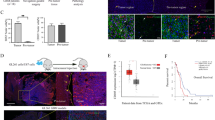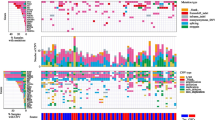Abstract
Glioblastoma multiforme (GBM) is a highly malignant brain tumor. Tumor stem cells have a major influence on tumor malignancy, and immunological escape mechanisms, involving the Natural Killer Group 2, member D (NKG2D) receptor-ligand-system, are key elements in tumor immuno-surveillance. We analyzed the expression profile and localization of NKG2D ligands (NKG2DL) and embryonic and neural stem cell markers in solid human GBM and stem-like cells isolated from glioma cell lines by qRT-PCR and immunohistochemistry, including quantitative analysis. We also evaluated the effect of Temozolomide (TMZ), the standard chemotherapeutic agent used in GBM therapy, on NKG2DL expression. NKG2DL-positive cells were mostly found scattered and isolated, were detectable in glial fibrillary acidic protein (GFAP)-positive tumor regions and partly in the penumbra of tumor vessels. NKG2DL were found in a distinct tumor stem-like cell subpopulation and were broadly costained with each other. Quantitative analysis revealed, that dependent on the individual NKG2DL investigated, cell portions costained with different stem cell markers varied between small (Musashi-1) and high (KLf-4) amounts. However, a costaining of NKG2DL with CD3γ, typically found in T cells, was also observable, whereas CD11b as a marker for tumor micoglia cells was only rarely costained with NKG2DL. Stem-like cells derived from the glioma cell lines T98G and U251MG showed a distinct expression pattern of NKG2DL and stem cell markers, which seemed to be balanced in a cell line-specific way. With differentiation, T98G displayed less NKG2DL, whereas in U251MG, only expression of most stem cell markers decreased. In addition, stimulation with TMZ led to a significant upregulation of NKG2DL in stem-like cells of both lines. As stem-like glioma cells tend to show a higher expression of NKG2DL than more differentiated tumor cells and TMZ treatment supports upregulation of NKG2DL, the NKG2D system might play an important role in tumor stem cell survival and in GBM therapy.






Similar content being viewed by others
References
Al-Hajj M, Wicha MS et al (2003) Prospective identification of tumorigenic breast cancer cells. Proc Natl Acad Sci USA 100(7):3983–3988
Aum DJ, Kim DH et al (2014) Molecular and cellular heterogeneity: the hallmark of glioblastoma. Neurosurg Focus 37(6):E11
Bao S, Wu Q et al (2006) “Glioma stem cells promote radioresistance by preferential activation of the DNA damage response. Nature 444(7120):756–760
Barker N, Ridgway RA et al (2009) Crypt stem cells as the cells-of-origin of intestinal cancer. Nature 457(7229):608–611
Bassoy EY, Chiusolo V et al (2016) Glioma stemlike cells enhance the killing of glioma differentiated cells by cytotoxic lymphocytes. PLoS One 11(4):e0153433
Beier CP, Kumar P et al (2012) The cancer stem cell subtype determines immune infiltration of glioblastoma. Stem Cells Dev 21(15):2753–2761
Bradshaw A, Wickremesekera A et al (2016) Cancer Stem Cells in Glioblastoma Multiforme. Front Surg 3:48
Bradshaw A, Wickremsekera A et al (2016) Cancer Stem Cell Hierarchy in Glioblastoma Multiforme. Front Surg 3:21
Carlsten M, Bjorkstrom NK et al (2007) DNAX accessory molecule-1 mediated recognition of freshly isolated ovarian carcinoma by resting natural killer cells. Cancer Res 67(3):1317–1325
Castriconi R, Dondero A et al (2007) Both CD133 + and CD133- medulloblastoma cell lines express ligands for triggering NK receptors and are susceptible to NK-mediated cytotoxicity. Eur J Immunol 37(11):3190–3196
Champsaur M, Lanier LL (2010) Effect of NKG2D ligand expression on host immune responses. Immunol Rev 235(1):267–285
Chitadze G, Bhat J et al (2013) Generation of soluble NKG2D ligands: proteolytic cleavage, exosome secretion and functional implications. Scand J Immunol 78(2):120–129
Chitadze G, Lettau M et al (2015) NKG2D- and T-cell receptor-dependent lysis of malignant glioma cell lines by human gammadelta T cells: Modulation by temozolomide and A disintegrin and metalloproteases 10 and 17 inhibitors. Oncoimmunology 5(4):e1093276
Chitadze G, Fluh C et al (2017) In-depth immunophenotyping of patients with glioblastoma multiforme: Impact of steroid treatment. Oncoimmunology 6(11):e1358839
Codo P, Weller M et al (2014) MicroRNA-mediated down-regulation of NKG2D ligands contributes to glioma immune escape. Oncotarget 5(17):7651–7662
Di Tomaso T, Mazzoleni S et al (2010) Immunobiological characterization of cancer stem cells isolated from glioblastoma patients. Clin Cancer Res 16(3):800–813
Fluh C, Hattermann K et al (2016) Differential expression of CXCR4 and CXCR7 with various stem cell markers in paired human primary and recurrent glioblastomas. Int J Oncol 48(4):1408–1416
Friese MA, Platten M et al (2003) MICA/NKG2D-mediated immunogene therapy of experimental gliomas. Cancer Res 63(24):8996–9006
Gasser S, Orsulic S et al (2005) The DNA damage pathway regulates innate immune system ligands of the NKG2D receptor. Nature 436(7054):1186–1190
Hattermann K, Held-Feindt J et al (2010) The chemokine receptor CXCR7 is highly expressed in human glioma cells and mediates antiapoptotic effects. Cancer Res 70(8):3299–3308
Hattermann K, Fluh C et al (2016) Stem cell markers in glioma progression and recurrence. Int J Oncol 49(5):1899–1910
Held-Feindt J, Hattermann K et al (2010) CX3CR1 promotes recruitment of human glioma-infiltrating microglia/macrophages (GIMs). Exp Cell Res 316(9):1553–1566
Ignatova TN, Kukekov VG et al (2002) Human cortical glial tumors contain neural stem-like cells expressing astroglial and neuronal markers in vitro. Glia 39(3):193–206
Jung TY, Choi YD et al (2013) Immunological characterization of glioblastoma cells for immunotherapy. Anticancer Res 33(6):2525–2533
Kmiecik J, Poli A et al (2013) Elevated CD3 + and CD8 + tumor-infiltrating immune cells correlate with prolonged survival in glioblastoma patients despite integrated immunosuppressive mechanisms in the tumor microenvironment and at the systemic level. J Neuroimmunol 264(1–2):71–83
Kreso A, Dick JE (2014) Evolution of the cancer stem cell model. Cell Stem Cell 14(3):275–291
Kruse V, Hamann C et al (2015) Human induced pluripotent stem cells are targets for allogeneic and autologous natural killer (NK) cells and killing is partly mediated by the activating NK receptor DNAM-1. PLoS One 10(5):e0125544
Lamb LS Jr, Bowersock J et al (2013) Engineered drug resistant gammadelta T cells kill glioblastoma cell lines during a chemotherapy challenge: a strategy for combining chemo- and immunotherapy. PLoS One 8(1):e51805
Lunemann A, Lunemann JD et al (2008) Human NK cells kill resting but not activated microglia via NKG2D- and NKp46-mediated recognition. J Immunol 181(9):6170–6177
Molinero LL, Fuertes MB et al (2002) Activation-induced expression of MICA on T lymphocytes involves engagement of CD3 and CD28. J Leukoc Biol 71(5):791–797
Nakamura K, Nakayama M et al (2013) Fratricide of natural killer cells dressed with tumor-derived NKG2D ligand. Proc Natl Acad Sci USA 110(23):9421–9426
Nausch N, Cerwenka A (2008) NKG2D ligands in tumor immunity. Oncogene 27(45):5944–5958
O’Connor ML, Xiang D et al (2014) Cancer stem cells: a contentious hypothesis now moving forward. Cancer Lett 344(2):180–187
Pende D, Rivera P et al (2002) Major histocompatibility complex class I-related chain A and UL16-binding protein expression on tumor cell lines of different histotypes: analysis of tumor susceptibility to NKG2D-dependent natural killer cell cytotoxicity. Cancer Res 62(21):6178–6186
Pereboeva L, Harkins L et al (2015) The safety of allogeneic innate lymphocyte therapy for glioma patients with prior cranial irradiation. Cancer Immunol Immunother 64(5):551–562
Raulet DH, Gasser S et al (2013) Regulation of ligands for the NKG2D activating receptor. Annu Rev Immunol 31:413–441
Salih HR, Antropius H et al (2003) Functional expression and release of ligands for the activating immunoreceptor NKG2D in leukemia. Blood 102(4):1389–1396
Salih HR, Holdenrieder S et al (2008) Soluble NKG2D ligands: prevalence, release, and functional impact. Front Biosci 13:3448–3456
Sottoriva A, Spiteri I et al (2013) Intratumor heterogeneity in human glioblastoma reflects cancer evolutionary dynamics. Proc Natl Acad Sci USA 110(10):4009–4014
Spreu J, Stehle T et al (2006) Human cytomegalovirus-encoded UL16 discriminates MIC molecules by their alpha2 domains. J Immunol 177(5):3143–3149
Stupp R, Hegi ME et al (2009) Effects of radiotherapy with concomitant and adjuvant temozolomide versus radiotherapy alone on survival in glioblastoma in a randomised phase III study: 5-year analysis of the EORTC-NCIC trial. Lancet Oncol 10(5):459–466
Vetter CS, Groh V et al (2002) Expression of stress-induced MHC class I related chain molecules on human melanoma. J Invest Dermatol 118(4):600–605
Watson NF, Spendlove I et al (2006) Expression of the stress-related MHC class I chain-related protein MICA is an indicator of good prognosis in colorectal cancer patients. Int J Cancer 118(6):1445–1452
Wolpert F, Tritschler I et al (2014) A disintegrin and metalloproteinases 10 and 17 modulate the immunogenicity of glioblastoma-initiating cells. Neuro Oncol 16(3):382–391
Wu J, Chalupny NJ et al (2003) Intracellular retention of the MHC class I-related chain B ligand of NKG2D by the human cytomegalovirus UL16 glycoprotein. J Immunol 170(8):4196–4200
Zeppernick F, Ahmadi R et al (2008) Stem cell marker CD133 affects clinical outcome in glioma patients. Clin Cancer Res 14(1):123–129
Acknowledgements
We thank Fereshteh Ebrahim and Brigitte Rehmke for expert technical support.
Funding
This work was supported by a sponsorship of the University Medical Center Schleswig–Holstein UKSH (Forschungsförderung 2016), which was given to CF, by the RTG2154 [project P7 (KHK) and P8 (JHF)] and by the popgen 2.0 network [P2N; supported by a grant from the German Ministry for Education and Research (01EY1103)].
Author information
Authors and Affiliations
Corresponding author
Ethics declarations
Conflict of interest
There are no conflicts of interest.
Rights and permissions
About this article
Cite this article
Flüh, C., Chitadze, G., Adamski, V. et al. NKG2D ligands in glioma stem-like cells: expression in situ and in vitro. Histochem Cell Biol 149, 219–233 (2018). https://doi.org/10.1007/s00418-018-1633-5
Accepted:
Published:
Issue Date:
DOI: https://doi.org/10.1007/s00418-018-1633-5




